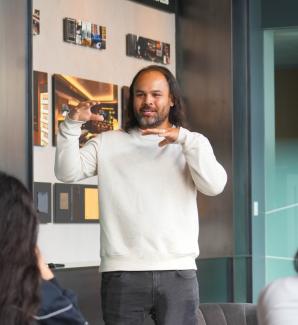
What do you do?
I'm a spatial epidemiologist for the Division of Environmental Public Health.
Describe your educational path. What was your area of study?
- Bachelor of Science in public health sciences
- Master of Public Health in epidemiology
- Certificate in geospatial analysis and visualization
How did you enter your career in public health?
To take the online version of human anatomy and physiology at my college I had to switch my major from biology to public health. So I switched.
During that semester, I had to write an essay about what I wanted to do with my major. I didn't know much about public health but told myself I would find a career in public health I could be excited about.
I ended up reading a World Health Organization article titled, "Macroeconomics and Health: Investing in Health for Economic Development" and was drawn into the idea that a relatively small investment in public health could produce huge gains in both economic and health outcomes across the world.
The publication said creating this future would in part require more epidemiologists and a related article mentioned the need for epidemiologists who used geographic information systems (GIS). I took those suggestions and began my current career path as an epidemiologist who specializes in GIS and data visualization.
What is the primary purpose of your team?
I'm on the Washington Tracking Network team. I see my team's work as two things: we create data visualizations and help others do environmental justice work in Washington state.
You can visit our team's website to view our data visualizations. These include dashboards and interactive tools for finding and downloading all sorts of public health data. Our visualizations focus on the "where" and include maps and data at different geographic levels.
From our website, you can also learn about our environmental justice work. Our team hosts and maintains the Environmental Health Disparities (EHD) map, which was called out in the Healthy Environment for All (HEAL) Act as one tool Washington state agencies will be using to improve their environmental justice efforts.
What is your typical day on the job?
Right now my job is 100% remote. So a typical day includes driving my youngest to school, then opening up my laptop to respond to messages from my team. Then I jump into my work, which includes either using Tableau to work on or update a data visualization, or programming in R to access, clean, re-structure, and prepare data for visualization.
With that said, I am not coding and visualizing data all day. Other steps in the process include brainstorming ideas with my team, discussing how racial equity and justice could be more supported through our work, meeting with others to understand their data visualization needs, preparing presentations, and working through issues as they arise.
What advice would you give a student pursuing career opportunities in public health? What is something you wish you knew earlier in your career?
My advice is don't be a generalist. Yes, the field of public health can be understood using general principles and a vision for public good and justice. But public health work is done by many people who fill niche roles.
I think you can fast-track your way to exciting public health opportunities by deciding what methods in public health you want to be doing and what public health problem you want to help solve.
For example, if you want to use qualitative methods to focus on the problems of racial differences in breast cancer, then that allows you to more clearly see what skill tree you want to learn and who in public health are leading the work on these issues so you can learn from their published work and reach out to them for advice.
Are there any books, podcasts, or other media that you would recommend for future public health professionals?
I'll share two:
- If you want to do data visualization work, I have found learning from visualization experts showcased in the Data Visualization Society's Information Is Beautiful Awards to be helpful and inspiring.
- If you want to help address racism as a public health crisis and do justice work, in addition to reading the work of giants in the justice movements ranging from Dr. Martin Luther King Jr. to people currently working in the public health field like Dr. Camara Jones, finding content that helps you better understand and process your own lived experience within a historical context will be very helpful.
